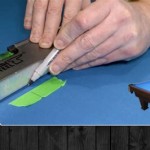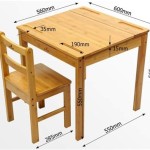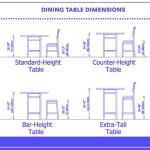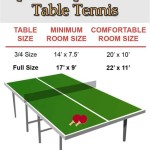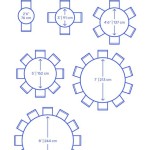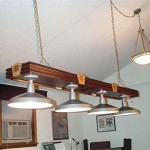Ping Pong Table Height in Inches: A Comprehensive Guide
Ping pong, also known as table tennis, is a globally recognized sport enjoyed by individuals of all ages and skill levels. The standardized dimensions of the playing surface are a crucial aspect of the game, ensuring fair play and consistent conditions for competition. One of the most important of these dimensions is the height of the table. Understanding the correct ping pong table height in inches is essential for players, manufacturers, and tournament organizers alike.
This article provides a comprehensive guide to the standardized height of a ping pong table, exploring the reasons behind this specific measurement, its impact on gameplay, and other related factors that contribute to the overall table tennis experience. It will delve into the regulations set forth by governing bodies like the International Table Tennis Federation (ITTF) and the considerations for accessible table tennis.
The Standard Ping Pong Table Height: 30 Inches
The official regulation height for a ping pong table is 30 inches (76 centimeters). This measurement is taken from the floor to the top surface of the table. This standard has been meticulously established and enforced by the ITTF to ensure uniformity across all levels of competitive play. The selection of this specific height is not arbitrary; it is based on a combination of factors related to ergonomics, gameplay dynamics, and historical precedent.
The rationale behind the 30-inch standard is multifaceted. It aims to provide a comfortable and balanced playing experience for individuals of varying heights. It allows players to effectively execute a range of strokes, including serves, forehand drives, backhand blocks, and smashes. A lower table height could disadvantage taller players, limiting their reach and impacting their ability to generate power. Conversely, a higher table height might make it difficult for shorter players to reach the ball and execute their shots effectively. The 30-inch standard represents a compromise that balances these considerations.
Furthermore, the height influences the trajectory of the ball during gameplay. A lower table could cause the ball to bounce lower, affecting the spin and speed of the shots. A higher table could lead to higher ball bounces, altering the defensive aspects of the game and potentially favoring certain playing styles. The established height allows for a fair distribution of both offensive and defensive opportunities, contributing to the dynamic and engaging nature of table tennis.
The enforcement of the 30-inch standard is critical for maintaining the integrity of competitive table tennis. Tournaments and competitions at the professional and amateur levels adhere strictly to this rule. Tables that deviate from the specified height are not permitted for official matches. This ensures that all players compete on a level playing field, where skill and strategy are the primary determinants of success, rather than variations in equipment.
Beyond competitive play, understanding the official table height is beneficial for recreational players as well. Setting up a table at the correct height can significantly improve the playing experience, making it more enjoyable and promoting the development of proper technique. It allows players to practice and hone their skills under conditions that closely resemble those encountered in official competitions.
Impact of Table Height on Gameplay
The height of a ping pong table has a profound impact on various aspects of gameplay. These are primarily related to the mechanics of strokes, the trajectory of the ball, and the overall flow of the game. Altering the table height can significantly change the way players approach the game, affecting their strategies and techniques.
For example, a table slightly lower than the standard 30 inches might favor players with quicker reflexes and a more aggressive playing style. The lower ball bounce would require faster reactions and allow for sharper angles on shots. This could also place an increased emphasis on serving techniques that produce low and deceptive bounces. However, this altered height could also disadvantage players who rely on looping shots and generating spin, as the lower bounce might make it difficult to impart significant rotation on the ball.
Conversely, a table slightly higher than the standard height could benefit players with a more defensive style of play. The higher ball bounce could provide more time to react and execute defensive shots. It could also make it easier to generate spin on looping shots, giving players more control over the trajectory and placement of the ball. However, this set up could potentially disadvantage players who prefer flat hits and quick attacks, as the higher bounce might allow opponents more time to react and defend.
The established 30-inch standard represents a balance between these extremes, promoting a diverse range of playing styles and allowing for a mix of offensive and defensive strategies. It allows players to make use of techniques like looping, blocking, smashing, and chopping. It encourages creativity and adaptability, as players must adjust their strategies based on the opponent's style and tendencies.
The height of the table also influences the effectiveness of various serving techniques. Certain serves are more effective at certain heights. A lower table might make it easier to execute serves that produce very low bounces, making it difficult for the receiver to return the ball effectively. On the other hand, a higher table might allow for serves with more spin and deception, as the higher bounce provides more time to impart rotation on the ball.
Ultimately, the standard table height is designed to provide a fair and engaging playing experience for all participants, regardless of their playing style or skill level. It creates conditions for dynamic and unpredictable gameplay, where strategic thinking and technical execution are key to success. Variations in table height can disrupt this balance and affect the overall integrity of the game.
ITTF Regulations and Table Specifications
The International Table Tennis Federation (ITTF) is the governing body responsible for establishing and enforcing the rules and regulations of the sport. These regulations cover all aspects of the game, including the specifications for the table, the net, the ball, and the racket. The ITTF regulations are designed to ensure fair play and consistent conditions for competition at all levels.
According to the ITTF Handbook for Match Officials, Section 2.01 outlines the precise specifications for the playing surface. Article 2.01.01 states: "The upper surface of the playing table, known as the playing surface, shall be rectangular, with a length of 2.74m and a width of 1.525m, and shall lie in a horizontal plane 76cm above the floor." This clearly defines the standard height of the table as 76 centimeters, which is equivalent to 30 inches.
The regulations also specify the materials and characteristics of the playing surface. The surface must be uniform in color, generally dark, and matt. It must provide a consistent bounce for the ball, ensuring predictability and fairness. The ITTF also approves specific brands and models of tables that meet these standards, assuring players and tournament organizers of their quality and compliance.
The ITTF also has rules regarding the tolerance of the height during competitions. There's an acceptable variance to the height of the table to account for slight imperfections in the manufacturing process and floor irregularities. However, it is normally a very small tolerance, ensuring that the height is very close to the stipulated 30 inches (76 cm).
The ITTF meticulously monitors the compliance of table manufacturers and tournament organizers with these regulations. Tables used in official ITTF-sanctioned events are subject to rigorous inspection to guarantee they meet the specified standards. Any deviation from the regulations can result in disqualification or other penalties. This stringent enforcement is crucial for maintaining the integrity of the sport and ensuring that all players compete on a level playing field.
In addition to the table height, other specifications related to the table are crucial. The dimensions of the net, including its height and length, are also regulated by the ITTF. These regulations work together to create a standardized playing environment that promotes fair play and consistent gameplay across all levels of competition. Adhering to these specifications is essential for both players and manufacturers to ensure the integrity of the sport.
Considerations for Accessible Table Tennis
While the standard ping pong table height of 30 inches is universally applied in competitive and recreational settings, modifications are sometimes necessary to make the sport more accessible to individuals with disabilities. Adaptive table tennis aims to provide opportunities for players with physical or cognitive impairments to participate and compete in the sport.
One of the most common adaptations involves adjusting the height of the table to accommodate wheelchair users. A standard table height may be difficult for individuals in wheelchairs to reach comfortably, potentially affecting their ability to execute shots effectively. In these cases, lowering the table by a few inches can significantly improve accessibility and allow wheelchair users to participate more fully in the game.
The specific height adjustment will depend on the individual's needs and preferences. It is recommended to consult with adaptive table tennis organizations and experienced coaches to determine the optimal table height for each player. In some cases, it may also be necessary to modify the legs of the table or use adjustable height tables to accommodate different players with varying needs.
Other adaptations may include using specialized rackets with modified grips, providing assistive devices to aid in mobility, and adjusting the rules of the game to accommodate specific disabilities. A key principle of adaptive table tennis is to create a fair and inclusive playing environment where all participants can compete and enjoy the sport regardless of their physical or cognitive limitations.
Creating accessible table tennis facilities requires careful consideration of various factors, including table height, wheelchair accessibility, adequate lighting, and appropriate signage. It is important to consult with disability advocates and experts to ensure that the facilities are designed to meet the needs of all users. Promoting accessibility in table tennis is not only a matter of fairness but also a valuable opportunity to foster inclusion and diversity within the sport.
By embracing adaptive table tennis and implementing thoughtful accommodations, the sport can become more inclusive and accessible to a wider range of individuals. This can provide opportunities for personal growth, social interaction, and physical activity for individuals with disabilities, further enriching the table tennis community.

Table Tennis Measurements Size And Dimensions Cornilleau

Ping Pong Table Dimensions The Guy

Table Tennis Dlgsc

Ping Pong Table Dimensions Ponghero

Table Tennis Room Size Court And Dimensions

To Choose The Right Table Tennis Size For You Stiga Sports

To Choose The Right Table Tennis Size For You Stiga Sports

Indoor Outdoor Foldable Mobile Table Tennis Cuu43327489 The Home Depot

Understand The Table In Tennis On Opponent S Size There Is 4 5 Feet Depth And Wide That Mean You Have Higher Chance Of Winning To Attac

Table Tennis Buyer S Guide Liberty

